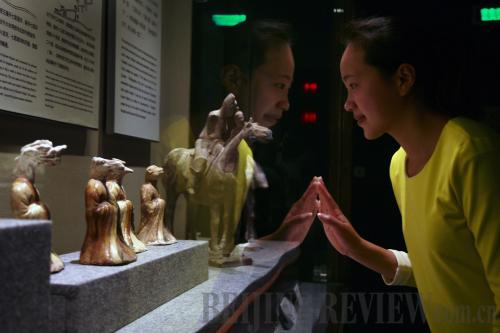|
 |
|
CLOSE TO THE PAST: A visitor looks at a display in Yangzhou Museum in Jiangsu Province on May 18, which was International Museum Day (XINHUA) |
Subsidies for Women
Over 3.6 million Chinese women had received micro-financing worth 180 billion yuan ($28.87 billion) by the end of March, according to a statement issued by the All-China Women's Federation on May 16.
Central and local government subsidies contributed more than 12 billion yuan ($1.92 billion) to this financing.
China began issuing micro-financing to women to encourage entrepreneurship and poverty reduction in 2009. The loans have helped boost the economy in underdeveloped western and rural regions, according to the federation.
Tibetology Databases
China will give importance to building research databases for Tibetology, according to the Fourth National Tibetology Coordination Meeting held in Beijing on May 17. The meeting is held every four years.
Tibetology institutes will boost their efforts to build databases of Tibetologists, their work and relevant policies, according to the meeting.
Aside from the databases, Tibetologists will also conduct systematic studies on Tibet's museum archives, stone tablet inscriptions, cultural relics, folk culture and Tibetan languages.
Since the last national meeting coordinating Tibetology research in China was held in 2010, several major research projects have been carried out, including studies on the Buddhist canon, the history of Tibet, the history of Tibetan Buddhism and the environment and landscape of the Tibetan Plateau.
New Jobs
China created 4.73 million jobs in the first four months of 2014, slightly more than the number created in the same period last year, figures from the Ministry of Human Resources and Social Security showed on Wednesday.
At the end of March, the country's registered urban unemployment rate stood at 4.08 percent.
The rate was 0.03 percentage points higher than at the end of last year.
In the first quarter, China's economic growth dipped to 7.4 percent, the lowest level since the third quarter of 2012.
Underwater Vessel
Testing of China's first underwater archaeological exploration vessel has begun in Chongqing Municipality.
The 500-tonne, 56-meter ship has a maximum displacement of 960 tons, and can carry a crew of 30, according to an official with the Chongqing Culture and Heritage Commission.
Underwater archaeology in China has made great strides since the 1980s and there are now a number of professional institutions and teams that work in the field. The lack of properly equipped vessels and ships has long been a problem.
This ship will continue testing in Shanghai before sailing out to the Xisha Islands in the South China Sea to commence operations. | 